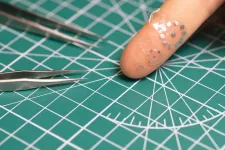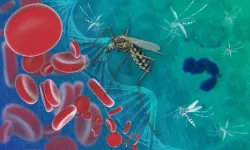(Press-News.org) A new device tested in pigs enables monitoring and early detection of pH changes in deep tissues due to post-operative leaks following gastrointestinal surgery. Such leaks – which occur at high rates 3-7 days following surgery – can be fatal if overlooked, and as such, require constant monitoring. Yet, early detection of these leaks remains a challenge. To address this need, Jaiqi Liu and colleagues developed a novel class of pH-responsive materials for real-time ultrasound measurement of pH changes indicative of leaks from healing surgical joins following gastrointestinal surgery. They dubbed their bioresorbable, shape-adaptive, ultrasound-readable materials structure, “BioSUM.” The thin and implantable device is comprised of small metal discs within a pH-responsive hydrogel. During recovery, the distance between the metal discs can be measured using ultrasound. Should a leak occur, the hydrogel reacts to the change in pH and swells, pushing the metal discs further apart, signaling a complication. This would allow intervention before further organ damage could occur. Moreover, the hydrogel can be tuned to the pH range native to where it is implanted, allowing leaks to be identified across several gastrointestinal organs, such as the stomach, small intestines, and pancreas. Liu et al. demonstrate the device in vivo across two small and large animal models, including pigs, which have a gastrointestinal tract similar to that of humans. “Monitoring technologies that meet societal demands for precise, personalized, and convenient health care are on the rise,” write Shonit Nair Sharma and Yuhan Lee in a related Perspective. “BioSUM, in its current iteration, introduces a platform technology that yields the potential to fit within a repertoire of emerging monitoring tools, such as capsule-based diagnostics and ophthalmic imaging techniques, that enhance the way that disease can be understood, monitored, and managed.”
END
Introducing BioSUM: a bioresorbable ultrasonic sensor to detect post-surgical leaks
2024-03-07
ELSE PRESS RELEASES FROM THIS DATE:
Rock weathering and climate: Low-relief mountain ranges are largest carbon sinks
2024-03-07
For many hundreds of millions of years, the average temperature at the surface of the Earth has varied by not much more than 20° Celsius, facilitating life on our planet. To maintain such stable temperatures, Earth must have a ‘thermostat’ that regulates the concentration of atmospheric carbon dioxide over geological timescales, influencing global temperatures. The erosion and weathering of rocks are important parts of this ‘thermostat.’ A team led by LMU geologist Aaron Bufe and Niels Hovius from the German Research Centre for Geosciences has now modeled the influence of these processes on carbon in the atmosphere. Their surprising result: CO2 capture through weathering ...
Often seen, never studied: First characterization of a key postsynaptic protein
2024-03-07
A protein that appears in postsynaptic protein agglomerations has been found to be crucial to their formation. The Kobe University discovery identifies a new key player for synaptic function and sheds first light on its hitherto uncharacterized cellular role and evolution.
What happens at the synapse, the connection between two neurons, is a key factor in brain function. The transmission of the signal from the presynaptic to the postsynaptic neuron is mediated by proteins and their imbalance can lead to neuropsychiatric ...
How does a virus hijack insect sperm to control disease vectors and pests?
2024-03-07
UNIVERSITY PARK, Pa. — A widespread bacteria called Wolbachia and a virus that it carries can cause sterility in male insects by hijacking their sperm, preventing them from fertilizing eggs of females that do not have the same combination of bacteria and virus. A new study led by microbiome researchers at Penn State has uncovered how this microbial combination manipulates sperm, which could lead to refined techniques to control populations of agricultural pests and insects that carry diseases like Zika and dengue to humans.
The study is published in the March 8 issue of the journal Science.
“Wolbachia is the most widespread bacteria in ...
How the brain coordinates speaking and breathing
2024-03-07
CAMBRIDGE, MA -- MIT researchers have discovered a brain circuit that drives vocalization and ensures that you talk only when you breathe out, and stop talking when you breathe in.
The newly discovered circuit controls two actions that are required for vocalization: narrowing of the larynx and exhaling air from the lungs. The researchers also found that this vocalization circuit is under the command of a brainstem region that regulates the breathing rhythm, which ensures that breathing remains dominant over speech.
“When you need to breathe in, you have to stop vocalization. We found that the neurons that control vocalization ...
Shape-shifting ultrasound stickers detect post-surgical complications
2024-03-07
EVANSTON, Ill. — Researchers led by Northwestern University and Washington University School of Medicine in St. Louis have developed a new, first-of-its-kind sticker that enables clinicians to monitor the health of patients’ organs and deep tissues with a simple ultrasound device.
When attached to an organ, the soft, tiny sticker changes in shape in response to the body’s changing pH levels, which can serve as an early warning sign for post-surgery complications such as anastomotic leaks. Clinicians then ...
The Malaria parasite generates genetic diversity using an evolutionary ‘copy-paste’ tactic
2024-03-07
By dissecting the genetic diversity of the most deadly human malaria parasite – Plasmodium falciparum – researchers at EMBL’s European Bioinformatics Institute (EMBL-EBI) have identified a mechanism of ‘copy-paste’ genetics that increases the genetic diversity of the parasite at accelerated time scales. This helps solve a long-standing mystery regarding why the parasite displays hotspots of genetic diversity in an otherwise unremarkable genetic landscape.
Malaria is most commonly transmitted through the bites of female Anopheles mosquitoes infected with P. falciparum. The latest world malaria report ...
Loss of nature costs more than previously estimated
2024-03-07
Researchers propose that governments apply a new method for calculating the benefits that arise from conserving biodiversity and nature for future generations.
The method can be used by governments in cost-benefit analyses for public infrastructure projects, in which the loss of animal and plant species and ‘ecosystem services’ – such as filtering air or water, pollinating crops or the recreational value of a space – are converted into a current monetary value.
This process is designed to make biodiversity loss and the benefits of nature conservation more visible in political decision-making.
However, the international research team ...
Lack of functional eyes does not affect biological clock in zebrafish
2024-03-07
Functional eyes are not required for a working circadian clock in zebrafish, as a research team1 including CNRS scientists has now shown.
Though it is understood that the eye plays a key role in mammalian adaptation to day-night cycles, the circadian clock is most often studied in nocturnal vertebrates such as mice. The zebrafish, in contrast, is a diurnal vertebrate. Through observation of various zebrafish larvae lacking functional eyes,2 the team of scientists has demonstrated that the latter are not needed to establish circadian rhythms that remain synchronized with light-dark ...
The who's who of bacteria: A reliable way to define species and strains
2024-03-07
What’s in a name? A lot, actually.
For the scientific community, names and labels help organize the world’s organisms so they can be identified, studied, and regulated. But for bacteria, there has never been a reliable method to cohesively organize them into species and strains. It’s a problem, because bacteria are one of the most prevalent life forms, making up roughly 75% of all living species on Earth.
An international research team sought to overcome this challenge, which has long plagued scientists who study bacteria. Kostas Konstantinidis, Richard ...
Forbes ranks the University of Colorado Denver | Anschutz Medical campus among America’s best employers
2024-03-07
The University of Colorado Denver | Anschutz Medical Campus is listed as one of Forbes America’s Best Large Employers for 2024.
The 2024 list of “America’s Best Employers” was conducted by Forbes and market research firm Statista, the world-leading statistics portal and industry ranking provider.
“This ranking is meaningful to our organization because the people who work at CU Anschutz drive our success as a leading academic medical campus by providing unparalleled patient care services, being a premier national leader in research and innovation, and fostering a supportive learning ...






